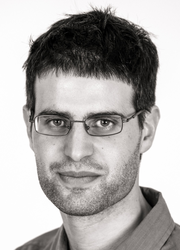Samuel Aldana
ContactDepartment of PhysicsUniversity of Basel Klingelbergstrasse 82 CH-4056 Basel, Switzerland
|

|
Short CV
| Since 04/2014 | Postdoctoral associate in the group of Christoph Bruder at the University of Basel |
| 04/2010 - 04/2014 | PhD in Physics in the Condensed Matter Theory group at the University of Basel, under the supervision of Christoph Bruder |
| 09/2008 - 02/2010 | MSc in Physics at the EPFL, diploma thesis under the supervision of Dmitri Ivanov |
| 10/2005 - 08/2008 | BSc of Physics at the EPFL |
Publications
Show all abstracts.| 1. | Detection of weak forces based on noise-activated switching in bistable optomechanical systems |
| Samuel Aldana, Christoph Bruder, and Andreas Nunnenkamp. Phys. Rev. A 90, 063810 (2014); arXiv:1409.8082
We propose to use cavity optomechanical systems in the regime of optical bistability for the detection of weak harmonic forces. Due to the optomechanical coupling an external force on the mechanical oscillator modulates the resonance frequency of the cavity and consequently the switching rates between the two bistable branches. A large difference in the cavity output fields then leads to a strongly amplified homodyne signal. We determine the switching rates as a function of the cavity detuning from extensive numerical simulations of the stochastic master equation as appropriate for continuous homodyne detection. We develop a two-state rate equation model that quantitatively describes the slow switching dynamics. This model is solved analytically in the presence of a weak harmonic force to obtain approximate expressions for the power gain and signal-to-noise ratio that we then compare to force detection with an optomechanical system in the linear regime.
| |
| 2. | Equivalence between an optomechanical system and a Kerr medium |
| Samuel Aldana, Christoph Bruder, and Andreas Nunnenkamp. Phys. Rev. A 88, 043826 (2013); arXiv:1306.0415
We study the optical bistability of an optomechanical system in which the position of a mechanical oscillator modulates the cavity frequency. The steady-state mean-field equation of the optical mode is identical to the one for a Kerr medium, and thus we expect it to have the same characteristic behavior with a lower, a middle, and an upper branch. However, the presence of position fluctuations of the mechanical resonator leads to a new feature: the upper branch will become unstable at sufficiently strong driving in certain parameter regimes. We identify the appropriate parameter regime for the upper branch to be stable, and we confirm, by numerical investigation of the quantum steady state, that the mechanical mode indeed acts as a Kerr nonlinearity for the optical mode in the low-temperature limit. This equivalence of the optomechanical system and the Kerr medium will be important for future applications of cavity optomechanics in quantum nonlinear optics and quantum information science.
| |
| 3. | Greenberger-Horne-Zeilinger generation protocol for N superconducting transmon qubits capacitively coupled to a quantum bus |
| Samuel Aldana, Ying-Dan Wang, and Christoph Bruder. Phys. Rev. B 84, 134519 (2011); arXiv:1104.1022
We propose a circuit quantum electrodynamics (QED) realization of a protocol
to generate a Greenberger-Horne-Zeilinger (GHZ) state for $N$ superconducting
transmon qubits homogeneously coupled to a superconducting stripline resonator
in the dispersive limit. We derive an effective Hamiltonian with pairwise qubit
exchange interactions of the XY type, $\tilde{g}(XX+YY)$, that can be globally
controlled. Starting from a separable initial state, these interactions allow
to generate a multi-qubit GHZ state within a time $t_{\text{GHZ}}\propto
\tilde{g}^{-1}$. We discuss how to probe the non-local nature and the genuine
$N$-partite entanglement of the generated state. Finally, we investigate the
stability of the proposed scheme to inhomogeneities in the physical parameters.
|
